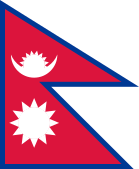Flag of Nepal
Jump to navigationJump to search
 |
|
| Name | Nepali Flag, Triangle Flag, Chandra ra Surya, Jungi Nishan |
|---|---|
| Use | Civil and state flag, national ensign |
| Proportion | see below |
| Adopted | 16 December 1962 |
| Design | A combination of two red pennons (pennants) with the large blue border around the unique shape of two overlapping right triangles: the smaller upper triangle bears the white stylised moon (the rising sun on the horizontal crescent moon) and the larger lower triangle displays the white twelve-pointed sun. |
The national flag of Nepal (Nepali: नेपालको झण्डा) is the world’s only non-quadrilateral flag that acts as both the state flag and civil flag of a sovereign nation.[1] The flag is a simplified combination of two single pennons (or pennants), known as a double-pennon. Its crimson red is the symbol of bravery and it also represents the color of the rhododendron, Nepal’s national flower, while the blue border is the color of peace. Until 1962, the flag’s emblems, the sun and the crescent moon, had human faces, but they were removed to modernize the flag.
The current flag was adopted on 16 December 1962, along with the formation of a new constitutional government.[2] It borrows from the original, traditional design,[3] used throughout the 19th and 20th centuries, and is a combination of the two individual pennons used by rival branches of the ruling dynasty.[1]
Contents
Symbolism[edit]
After Prithvi Narayan Shah unified all small principalities of Nepal, the double-pennon flag was adopted. In modern times, the flag’s symbolism has evolved to incorporate several meanings. The crimson red indicates the bravery of Nepali people and is the country’s national color and the blue border represents peace and harmony. The colors are often found in Nepalese decoration and works of art.[2] The triangular shape of the pennons originally represented the Himalayas, with their size denoting important families – Shahs for the upper, and the Ranas below. Another theory is that the two points represented peace and hard work, using the symbols of the moon and sun respectively. However, the modern and government-sanctioned representation is of Hinduism and Buddhism, the main religions of the country.[4][5]
The inclusion of the celestial bodies indicates Nepal’s permanence and the hope that Nepal will enjoy the same longevity as the Sun and the Moon. Additionally, the stylized moon represents the calm demeanor and purity of spirit of the Nepali people, while the stylized sun represents their fierce resolve[citation needed]. Further, the moon also symbolizes the cool weather of the Himalayas, whereas the sun symbolizes the heat and the high temperature of the Nepali lowlands (Terai).[4]
In Bharat Barsa aka during ancient times, all the flags were triangular in the Indian Subcontinent. Nepal has simply maintained its ancient tradition more than 2000 years ago, while every other one has an adopted rectangular or square western version. In various countries of India, a triangular shape flag was also used. Uses in the state of Nagpur, Kurundwad State, etc but were suppressed later.[6]
[7]The old flag of Nepal
Flag layout[edit]
A precise geometrical description of the Nepalese national flag is specified in the Constitution of the Kingdom of Nepal, Article 5, Schedule 1, adopted 9 November 1990.[8]
Aspect ratio[edit]
According to the stated geometric construction law, the circumscribed rectangle has an irrational ratio of:
- {\displaystyle 1:{\frac {6136891429688-306253616715{\sqrt {2}}-{\sqrt {118-48{\sqrt {2}}}}\left(934861968+20332617192{\sqrt {2}}\right)}{4506606337686}}}
≈ 1:1.21901033… (OEIS: A230582).[9] This ratio is the least root of the quartic polynomial[10]
- {\displaystyle 243356742235044r^{4}-1325568548812608r^{3}+2700899847521244r^{2}-2439951444086880r+824634725389225,}
and arises from the addition of the blue border after construction of the red field. The bounding rectangle of the red field alone has the rational aspect ratio 3:4 (=1:1.333…).[8]
Other flags[edit]
-
 Flag of Mustang
Flag of Mustang
Incorrect versions[edit]
This is the flag of Nepal used for the 2016 Summer Olympics. It has the transparency turned off.
Because it is a flag of unique proportions and specificities, its large-scale production becomes difficult and usually overlaid on a white area to make the flag a 3:2 ratio; an example is the Nepalese flag used at the venues of the 2016 Summer Olympics.[11] The flag of Ohio, another non-quadrilateral civil flag, has also been turned into a rectangle by mistake.[12]
During a 2018 visit of the Prime Minister of India to Janakpur, a version of the flag with incorrect shape and geometrical proportions was flown by officials, causing outrage on social media and with national personnel.[13][14]





